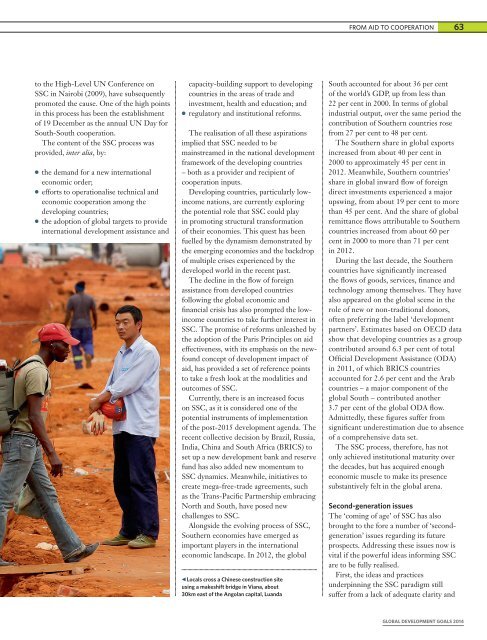FAMBB
FAMBB
FAMBB
Create successful ePaper yourself
Turn your PDF publications into a flip-book with our unique Google optimized e-Paper software.
FROM AID TO COOPERATION63to the High-Level UN Conference onSSC in Nairobi (2009), have subsequentlypromoted the cause. One of the high pointsin this process has been the establishmentof 19 December as the annual UN Day forSouth-South cooperation.The content of the SSC process wasprovided, inter alia, by:●●the demand for a new internationaleconomic order;●●efforts to operationalise technical andeconomic cooperation among thedeveloping countries;●●the adoption of global targets to provideinternational development assistance andcapacity-building support to developingcountries in the areas of trade andinvestment, health and education; and●●regulatory and institutional reforms.The realisation of all these aspirationsimplied that SSC needed to bemainstreamed in the national developmentframework of the developing countries– both as a provider and recipient ofcooperation inputs.Developing countries, particularly lowincomenations, are currently exploringthe potential role that SSC could playin promoting structural transformationof their economies. This quest has beenfuelled by the dynamism demonstrated bythe emerging economies and the backdropof multiple crises experienced by thedeveloped world in the recent past.The decline in the flow of foreignassistance from developed countriesfollowing the global economic andfinancial crisis has also prompted the lowincomecountries to take further interest inSSC. The promise of reforms unleashed bythe adoption of the Paris Principles on aideffectiveness, with its emphasis on the newfoundconcept of development impact ofaid, has provided a set of reference pointsto take a fresh look at the modalities andoutcomes of SSC.Currently, there is an increased focuson SSC, as it is considered one of thepotential instruments of implementationof the post-2015 development agenda. Therecent collective decision by Brazil, Russia,India, China and South Africa (BRICS) toset up a new development bank and reservefund has also added new momentum toSSC dynamics. Meanwhile, initiatives tocreate mega-free-trade agreements, suchas the Trans-Pacific Partnership embracingNorth and South, have posed newchallenges to SSC.Alongside the evolving process of SSC,Southern economies have emerged asimportant players in the internationaleconomic landscape. In 2012, the globalLocals cross a Chinese construction siteusing a makeshift bridge in Viana, about30km east of the Angolan capital, LuandaSouth accounted for about 36 per centof the world’s GDP, up from less than22 per cent in 2000. In terms of globalindustrial output, over the same period thecontribution of Southern countries rosefrom 27 per cent to 48 per cent.The Southern share in global exportsincreased from about 40 per cent in2000 to approximately 45 per cent in2012. Meanwhile, Southern countries’share in global inward flow of foreigndirect investments experienced a majorupswing, from about 19 per cent to morethan 45 per cent. And the share of globalremittance flows attributable to Southerncountries increased from about 60 percent in 2000 to more than 71 per centin 2012.During the last decade, the Southerncountries have significantly increasedthe flows of goods, services, finance andtechnology among themselves. They havealso appeared on the global scene in therole of new or non-traditional donors,often preferring the label ‘developmentpartners’. Estimates based on OECD datashow that developing countries as a groupcontributed around 6.3 per cent of totalOfficial Development Assistance (ODA)in 2011, of which BRICS countriesaccounted for 2.6 per cent and the Arabcountries – a major component of theglobal South – contributed another3.7 per cent of the global ODA flow.Admittedly, these figures suffer fromsignificant underestimation due to absenceof a comprehensive data set.The SSC process, therefore, has notonly achieved institutional maturity overthe decades, but has acquired enougheconomic muscle to make its presencesubstantively felt in the global arena.Second-generation issuesThe ‘coming of age’ of SSC has alsobrought to the fore a number of ‘secondgeneration’issues regarding its futureprospects. Addressing these issues now isvital if the powerful ideas informing SSCare to be fully realised.First, the ideas and practicesunderpinning the SSC paradigm stillsuffer from a lack of adequate clarity andGLOBAL DEVELOPMENT GOALS 2014


